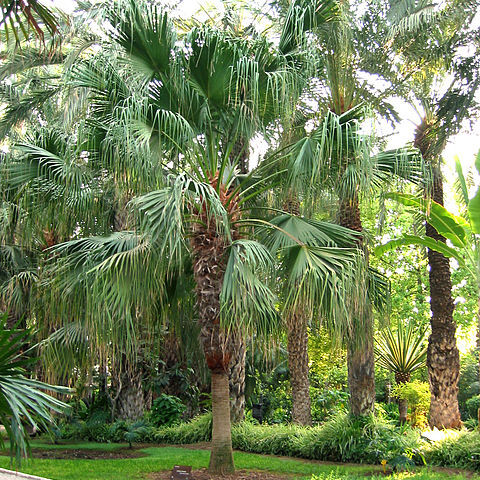Plants small to large. Stems solitary, erect, slender (rarely) to robust (more than 20 cm diam.), at first covered by persistent leaf sheaths, later becoming bare or covered with persistent petiole bases, ringed conspicuously or obscurely with leaf scars. Leaves: petiole not split at base, strongly armed [unarmed]; abaxial hastula minute or absent; adaxial hastula conspicuous; blade palmate or costapalmate; plication induplicate; segments basally connate, lanceolate, not producing fibers between segments. Inflorescences axillary within crown of leaves, paniculate with 3--5 orders of branching, about as ± as long as leaves; prophyll membranaceous; peduncular bracts many, obscuring rachis; rachillae pubescent. Flowers bisexual [unisexual], borne singly along rachillae [in small groups]; perianth 2-seriate; calyx cupulate, 3-lobed; corolla 3-lobed, valvate; stamens 6, connate in short tube; gynoecium: pistils 3, distinct basally, glabrous; styles connate, slender. Fruits drupes; exocarp blackish, smooth; mesocarp fleshy; endocarp bony. Seeds globose or ellipsoid; endosperm homogeneous; embryo lateral; eophyll undivided, lanceolate. xn = 18.
Stems solitary, often large and stout, usually rough with persistent leaf bases. Leaves 10-60, palmate or costapalmate, usually forming a dense crown; dead leaves often persisting as a skirt below crown; leaf sheaths open and often very fibrous, forming a mass of reddish brown, interwoven fibers; petioles spiny on margins, younger plants with more spines than older ones; hastula present; blades green or variously waxy or dull green, divided to ca. 1/2 their length or almost to base into many segments, these again split and sometimes pendulous at apices. Inflorescences borne among leaves, branched up to 5 orders, rarely an inflorescence consisting of 3 separate but equal branches arising from same prophyll; inflorescences covered with many sheathing bracts; flowers usually borne in small groups, bisexual with 6 stamens and 3 carpels; rarely plants functionally dioecious. Fruits bluish or variously colored, globose to ellipsoid, 1-seeded, usually borne on short stalks; endosperm homogeneous, with an irregular intrusion of seed coat; germination remote; eophylls undivided and lanceolate.
Trunks usually tall, distinctly ringed below, clothed above with old fibrous leaf-sheaths. Leaves in a terminal crown, fan-shaped, plicate, orbicular, split to middle or below into numerous segments, often bifid at tip, and induplicately inserted on axis (V shaped in T.S.); frequently a small bristle or filament between segments; petiole long, usually spiny on margins. Inflorescence a loose, often much-branched panicle borne amongst leaves on a long peduncle, erect but drooping in fruit; spathes subtending main rhachis and secondary branches tubular, compressed, leathery. Flowers bisexual, greenish, very small. Fruit globose to ellipsoid, reduced by abortion to one carpel; exocarp smooth, mesocarp thin, fleshy, endocarp thin, hard. Spp. c. 30, of tropical Asia and Australia. Adventive sp. 1.

